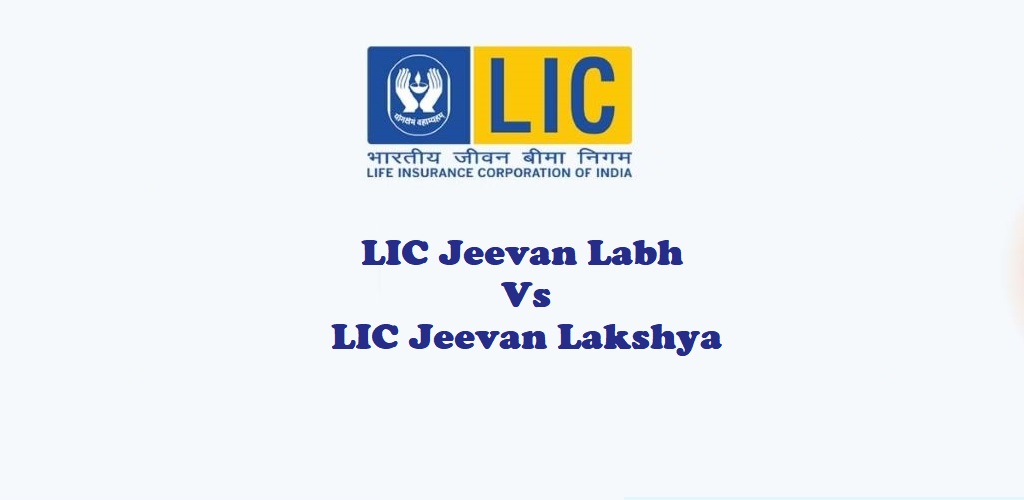Whenever it comes to investing money, it is always better to look for an option where our money is not only safe but also offers good profit after a certain period of time. One can get such facilities with LIC policies, such as LIC Jeevan Labh and LIC Jeevan Lakshya.
Both policies can help the policyholders to get good returns in the future and, at the same time, good protection of the funds. The benefits of protection and savings are the cornerstone of both plans. Comparing the two, though, reveals special qualities that cater to the various needs of policyholders.
Let’s briefly go over the two plans and discover how they differ from each other.
What Is LIC Jeevan Labh Policy?
LIC Jeevan Labh is a participating, non-linked, individual, life assurance savings plan that claims to offer a perfect amalgamation of protection and savings in one plan. This plan’s yearly income benefit, which is provided to the dependents in the event of the policyholder’s passing, is an important feature to discuss. Additionally, LIC provides a maturity reward upon surviving the entire policy period.
What Is LIC Jeevan Lakshya Policy?
LIC Jeevan Lakhsya is a non-linked and participating plan from LIC that also combines savings and protection. In the event that the policyholder passes away before maturity, this plan offers an annual income benefit that may help the family meet its financial obligations, especially for the benefit of the children, as well as a lump sum payment at maturity regardless of the policyholder’s survival.
Key Features & Benefits Of LIC Jeevan Labh Plan
Some of the major features and benefits of LIC Jeevan Labh plan are as follows:
Death Benefit:
The nominee will be entitled to receive the following benefits in the event of the insured’s death:
- Sum Assured (105% of all premiums paid or more must be guaranteed).
- Any Simple Revolutionary Bonuses (10 times the Annualised Premium or the Basic Sum Assured, whichever is greater).
- The nominee will receive any remaining extra bonuses.
Maturity Benefit:
The following advantages are given to the insured when the policyholder lives through the insurance period:
- Sum Assured on Maturity.
- Any Simple Revolutionary Bonuses (determined based on LIC’s experience).
- Any remaining additional bonuses.
Rebates:
Customers frequently receive discounts from LIC in exchange for a variety of benefits. Rebate depends on the form of premium payment:
- Yearly mode: 2% of table premium
- Half-yearly mode: 1% of table premium
And for higher sum assured, the benefits are as follows:
| Basic Sum Assured (BSA) | Rebates Given |
| Rs. 5 Lakhs To Rs. 9,90,000 | 1.25% Of BSA |
| Rs. 10 Lakhs To Rs. 14,90,000 | 1.50% Of BSA |
| Rs. 15 Lakhs & Above | 1.75% Of BSA |
Grace Period:
For yearly, half-yearly, and quarterly payment modes, the grace period offered by the plan is 30 days. However, it is 15 days for the monthly payment mode.
Payment Of Premium:
The policyholders have the option to pay premiums through yearly, half-yearly, quarterly, or monthly modes.
Loan Facility:
As per the terms and conditions of the plan and the corporation, a policyholder can avail of the loan facility under the plan provided that he/she has paid at least two years of the full premium amount.
Free Look Period:
In case the policyholder is not happy with the terms and conditions of the plan, he/she can cancel the policy and return it to the company within 15 days from the date of receipt of the policy.
Suicide Exclusion:
If the insured individual dies by suicide within a year of the policy’s effective date, the insurance company is not obligated to pay the nominee(s) any Sum Assured. However, 80% of the premiums, without any interest, will be paid to the nominee(s) in suicide instances that occur more than a year into the policy’s term.
Key Features & Benefits Of LIC Jeevan Lakshya Plan
Here are some of the important features and benefits of the plan:
Death Benefit:
The Death Benefit, defined as the amount of the “Sum Assured on Death,” vested Simple Reversionary Bonuses, and Final Additional Bonus, if any, shall be payable upon the death of the Life Assured before the specified date of maturity provided the policy is in full effect by paying current premiums.
Maturity Benefit:
In the event that a policyholder survives to the end of the policy term and all due premiums have been paid, a lump sum payment equal to the “Sum Assured on Maturity” equivalent to the Basic Sum Assured, along with any vested Simple Reversionary Bonuses and Final Additional Bonuses, will be made.
Participation In Profits:
If the policy is in full force, it will share in the corporation’s profits and be eligible to collect Simple Reversionary Bonuses that are declared based on the corporation’s experience.
The entire vested Simple Reversionary Bonuses and Final Additional Bonus, if any, shall be payable on the due date of maturity in the event of death under a policy that is in full effect. The policy will stop sharing in future profits if the premiums are not paid in a timely manner (with the exception of a life assured under an active policy), whether or not the policy has accrued paid-up value. However, during the grace period, the policy will be regarded as being in effect on death.
Payment Of Premiums:
Throughout the premium-paying term, premiums can be paid on schedule at intervals of annually, half-yearly, quarterly, or monthly (through ECS or salary deductions).
Grace Period:
For the payment of annual, biannual, or quarterly premiums, a grace period of one month but no less than 30 days will be permitted, and for monthly payments, a grace period of 15 days will be given.
Rebates:
As discussed above, LIC typically offers discounts to customers in return for a number of advantages. Refunds vary depending on how premiums are paid:
- Yearly mode: 2% of table premium
- Half-yearly mode: 1% of table premium
For higher sum assured ranges, the rebates are as follows:
| Basic Sum Assured (BSA) | Rebate (In Rs.) |
| Rs. 2,00,000 To Rs. 4,90,000 | 2% Of BSA |
| Rs. 5 Lakhs & Above | 3% Of BSA |
Loan Facility:
If the insurance has acquired surrender value, a loan may be obtained under it, subject to the terms and conditions that the corporation may from time to time designate.
Suicide Exclusion:
Similar to LIC Jeevan Labh, Jeevan Lakshya policy also has a suicide exclusion. The insurance company has no obligation to pay the nominee(s) any Sum Assured if the insured person commits suicide within a year of the policy’s start date. However, in cases of suicide that take place more than a year into the policy’s term, 80% of the premiums, without any interest, will be paid to the nominee(s).
Differences Between LIC Jeevan Labh & LIC Jeevan Lakshya
After discussing deeply both plans, let’s skim the major differences between the two:
| Parameters | LIC Jeevan Labh | LIC Jeevan Lakshya |
| Minimum Entry Age | 8 Years | 18 Years |
| Maximum Entry Age | For Policy Term 16 Years: 59 Years For Policy Term 21 Years: 54 Years For Policy Term 25 Years: 50 Years | 50 Years |
| Policy Term | 16, 21, & 25 Years | 13 To 25 Years |
| Maximum Maturity Age | 75 Years | 65 Years |
| Minimum Basic Sum Assured | Rs. 2 Lakhs | Rs. 1 Lakh |
| Note: There is no limit for the maximum sum assured for both plans. | ||
| Rider Options |
|
|
Which Is Better: LIC Jeevan Lakshya OR LIC Jeevan Labh
Both the plans, LIC Jeevan Labh and LIC Jeevan Lakshya are specifically designed while keeping in the idea of comprehensive insurance. However, as evident from the above differences, these two plans have distinctive elements that help them meet the various needs of policyholders.
In case a person is looking for a wide range of entry ages, a higher maturity age limit, and a greater number of rider options, clearly LIC Jeevan Labh wins the race. There is no denying the fact that LIC Jeevan Labh plan will offer wonderful returns, but in case an individual.







